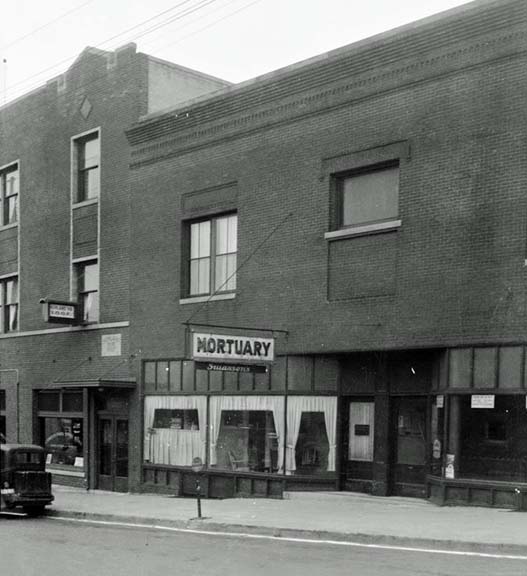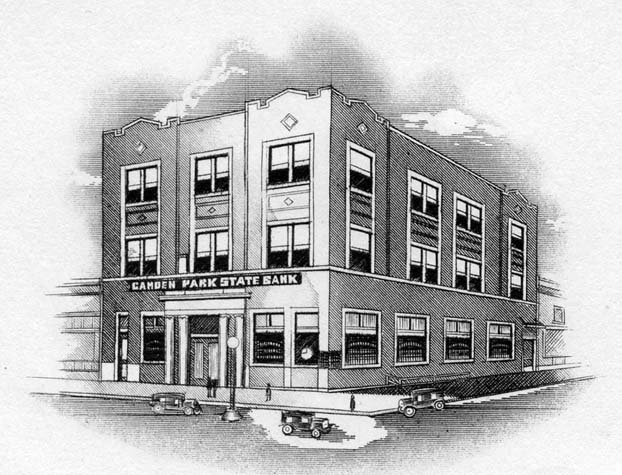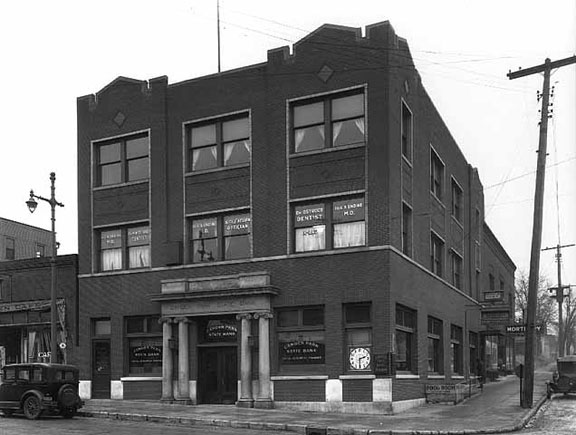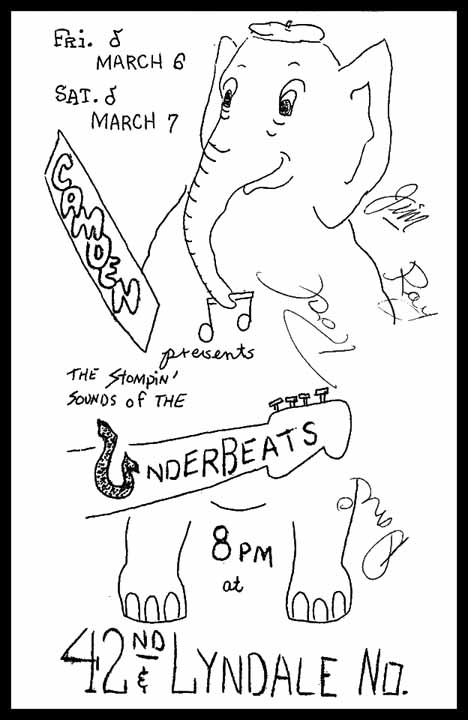Camden Bank
42nd Ave. No. and Lyndale Ave. No.
Minneapolis
The Camden Bank building was built in two sections:
1910 BUILDING
In 1910 the Odd Fellows Highland Lodge No. 99 purchased the block and built a two-story building facing 42nd Ave. No. as their IOOF Lodge. The address of this building 707 – 709 42nd Ave. No.
The building was designed by Septimus J. Bowler and constructed for $9,000 by Charles E. Hagstrom. In the beginning, the first floor of this building was used as an “undertaker’s parlor” and post office. The second floor was ballroom with an octagonal dome in the ceiling.

1936 photo courtesy Minnesota Historical Society
1920 BUILDING
In 1920 the IOOF Lodge built a $40,000 three-story addition to the first building, facing Lyndale. The building replaced three frame stores that had been built in the 1890s.
The architect was Ernest C. Haley, and the builder was Charles J. Johnston. The original address of this building was 4169 – 4171 Lyndale Ave. No. The permit card described this as “bank and lodge hall.” The basement was originally used as a pool room and bar. The original plans call for the third floor to be used partly as a banquet hall with kitchen.

Artist’s conception, presumably by E.C. Haley. Courtesy Richard Sigurdson

1928 photo courtesy Minnesota Historical Society
For years the two sections had two addresses, as listed above. They are, and always have been one building, in actuality, and have always had one owner. It now carries the address 705 42nd Ave. No.
THE BANK
My friend Richard Sigurdson provided some history of the bank and his grandfather:
The Camden Bank was organized on October 3, 1910, and was originally located on Washington Ave. In 1920 it moved to the new building on Lyndale and 42nd Street.
In 1910, Goodman G. Sigurdson, a native of Iceland, moved to Minneapolis in October 1910, and helped organize the Camden Park State Bank. He was the first head cashier when the bank opened. He served as president from 1922 until 1953, when he was appointed Chairman of the Board, position he held until his retirement in December 1956. In 1955 the bank moved to 4141 North Lyndale. It was sold to Norwest Bancorp, which is now Wells Fargo.
DANCES
The second floor of the 1910 building on 42nd Ave. No. was a ballroom, and in 1959 North High student Marsh Edelstein started to organize dances on Friday and Saturday nights. He wanted a place that was available to kids from North and Edison Highs, and its popularity spread to kids from other high schools to become one of the biggest Minneapolis hangouts.
Local bands were booked for the dances: the DelCounts, the Underbeats, the Accents, the Trashmen, Castaways, Avanties, etc. Rod Eaton of the Underbeats shares the flyer below and his memories of the venue:

Courtesy Rod Eaton
Rod:
Here’s a flyer for a dance at Camden. It’s just five by eight inches but it tells a big story. Sitting on the corner of 42nd and Lyndale Avenue North is a brick building. It’s a restaurant now, I think. But the second floor was an open rental space – people held wedding receptions and parties there. When the teen dance craze hit in the early ’60s, a couple of enterprising young men saw the space as college tuition. They promoted dances there every Friday and Saturday. It was always just called Camden.
Bands should have been paid more to play there – the only access was up a long flight of stairs. It wasn’t a lot of fun getting all our amps and drums up those steps. I pitied any band with a Hammond B3.
But once you muscled the gear up Camden became a truly jumping place. For starters it drew big throngs of kids. Then there was the floor – it literally bounced up and down when kids danced. You could feel it. I played in continual fear that we’d find ourselves suddenly on the first floor. That fear turned to panic when we played “Foot Stompin.’” Dancers would jump on the floor to every beat of the drums – boom, boom, BOOM, BOOM! Dust billowed up, the walls shook, the floor trembled. They loved it – we generally had to play the song twice a night. This flyer exploits that: “Presenting the Stompin’ sounds of the Underbeats.”
In a way Camden was home to the Underbeats. That was our side of the city, and we had a lot of friends in the neighborhood – it’s where we got our start. Camden may have been the reason we made “Foot Stompin’” our first record.
Some kids remember fights there, but Marsh says he had good security there. He moved his operation to the Marigold Ballroom in 1962 because the Bank was not big enough and he wanted to bring in national acts like Chuck Berry, Bo Diddley, Little Anthony, etc.
In 1969 the building hosted a 181-seat theater to present live dramatic plays.
Throughout its life the Camden Bank building has housed a post office, pool hall, and professional offices. It is one of the only remaining buildings in the neighborhood, due to the construction of I-94, which the 1920 section faces, across Lyndale Ave. It is a welcome reminder of Old Camden, with its “I.O.O.F. No. 99” still engraved above the entrance of the 1910 section, and “Camden Park State Bank” still engraved above thee central main entry of the 1920 section.


